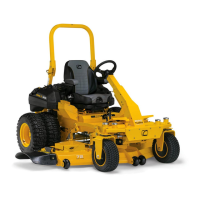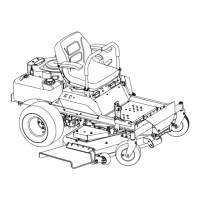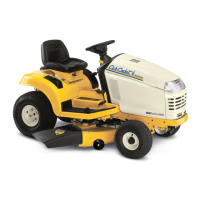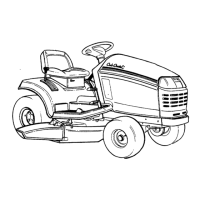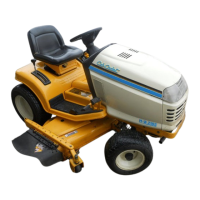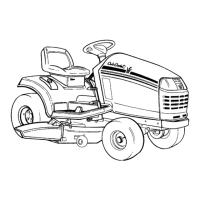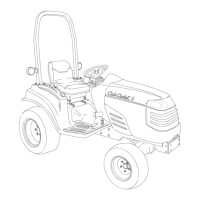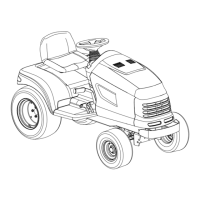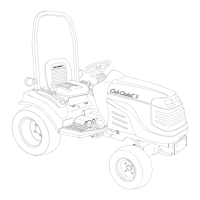3Section 1 — Safe operation practiceS
28. Do not stop or park the machine over
dry leaves, grass, debris, or other
combustible material.
29. Never attempt to operate the machine
without the mowing deck attached; the
machine could tip over.
30. Keep the machine and especially the
engine exhaust system and hydraulic
components clean and free of grease,
grass, and leaves to reduce the potential
for overheating and fire.
31. Allow the machine to cool at least 5
minutes before storing.
32. Use only accessories and attachments
approved for this machine by the
machine manufacturer. Read,
understand, and follow all instructions
provided with the approved accessory
or attachment.
33. Data indicates that operators, age 65
years and above, are involved in a large
percentage of riding mower-related
injuries. Operators should evaluate their
ability to operate this machine safely
enough to protect themselves and
others from serious injury.
34. Do not operate or start machine if there
are fuel or oil leaks; repair immediately.
35. When looking for oil leaks, never run
your hand over hydraulic hoses, lines,
or fittings. Never tighten or adjust
hydraulic hoses, lines, or fittings
while the system is under pressure. If
high-pressure oil penetrates the skin
seek immediate medical attention or
gangrene and permanent damage may
result. Do not check for hydraulic leaks
with your hands, use paper or cardboard
instead. Wear gloves and safety glasses
when checking for leaks.
36. Do not operate machines that have been
damaged or have not been properly
maintained. If the machine has been
damaged, then have it repaired.
37. When operating this machine in the
forward direction, do not allow the
speed control levers to return to the
neutral position on their own. Always
operate them smoothly and avoid any
sudden movements of the levers when
starting or stopping.
38. If situations occur which are not covered
in this manual use care and good
judgement. Contact your customer
service representative for assistance.
Slope Operation
Slopes are a major factor related to loss of
control and tip-over accidents that can result in
severe injury or death. All slopes require extra
caution. If you cannot back up the slope or if
you feel uneasy on it, do not mow it or drive on
the slope.
For your safety, use the slope gauge included
as part of this manual to measure slopes before
operating this machine on a sloped or hilly
area. If the slope is greater than 15°/25% as
shown on the slope gauge, do not operate
this machine on that area or serious injury
could result.
Do:
1. Mow across slopes, not up and down.
Exercise extreme caution when
changing direction on slopes.
2. Watch for holes, ruts, bumps, rocks, or
other hidden objects. Uneven terrain
could overturn the machine. Tall grass
can hide obstacles.
3. Use slow speed. Choose a low enough
speed so that you will not have to stop
while on the slope. Avoid starting or
stopping on a slope. If the tires are
unable to maintain traction, disengage
the blades and proceed slowly and
carefully straight down the slope.
4. Keep all movements on the slopes
slow and gradual. Do not make sudden
changes in speed or direction. Rapid
acceleration could cause the front of
the machine to lift and rapidly flip over
backwards, which could cause serious
injury or death.
5. Follow the manufacturer’s
recommendations for wheel weights or
counterweights to improve stability.
6. Use extra care with grass catchers or
other attachments. These can change
the stability of the machine.
Do Not:
1. Do not turn on slopes unless necessary;
then turn slowly uphill and use extra care
while turning.
2. Do not mow near drop-offs, ditches,
or embankments. The machine could
suddenly turn over if a wheel is over the
edge of a cliff, ditch, or if an edge caves in.
3. Do not operate on slopes or near the
edge of water such as a lake, pond, river,
or stream where the machine could slip,
tip, or roll-over into the water.
4. Do not try to stabilize the machine by
putting your foot on the ground.
5. Use extra care while operating tractor
with grass catcher or other
attachment(s). They can affect the
stability of the tractor. Do not use grass
catcher on slopes greater than 10° (17%).
6. Do not mow on wet grass. Reduced
traction could cause sliding and/or loss
of control.
7. Do not tow heavy pull behind
attachments (e.g. loaded dump cart,
lawn roller, etc.) on slopes greater than
5°. When going downhill, the extra
weight tends to push the machine and
may cause loss of traction and loss of
control (e.g. machine may speed up,
braking and steering ability are reduced,
attachment may jack-knife, and cause
machine to overturn).
Children
1. Tragic accidents can occur if the
operator is not alert to the presence of
children. Children are often attracted to
the machine and the mowing activity.
They do not understand the dangers.
Never assume that children will remain
where you last saw them.
a. Keep children out of the mowing
area and in watchful care of a
responsible adult other than
the operator.
b. Be alert and turn machine off if a
child enters the area.
c. Always look behind and down for
small children. Use slow speed.
d. Never carry children, even
with the blade(s) shut off. They
may fall off and be seriously
injured or interfere with safe
machine operation.
e. Use extreme care when
approaching blind corners,
doorways, shrubs, trees, or other
objects that may block your
vision of a child who may run into
the path of the machine.
f. To avoid back-over accidents,
always disengage blades before
traveling in reverse.
g. Keep children away from hot or
running engines. They can suffer
burns from a hot muffler.
h. Remove key when machine
is unattended to prevent
unauthorized operation.
2. Never allow children under 16 years of
age to operate this machine. Children 16
and over should read and understand
the instructions and safe operation
practices in this manual and on the
machine and should be trained and
supervised by an adult.
Towing
1. Do not tow heavy tow-behind
attachments (e.g. loaded dump cart, lawn
roller, etc.) on slopes greater than 5°.
2. Tow only with a machine that has a hitch
designed for towing. Do not attach towed
equipment except at the hitch point.
3. Follow the manufacturer’s
recommendation for weight limits for
towed equipment and towing on slopes.
4. Never allow children or others in or on
towed equipment.
5. On slopes, the weight of the towed
equipment may cause loss of traction and
loss of control.
6. Travel slowly and allow extra distance
to stop.
7. Make wide turns to avoid jack knifing.
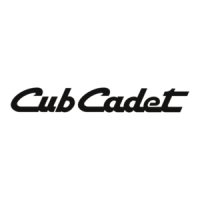
